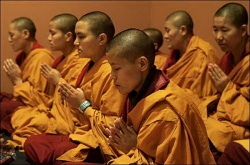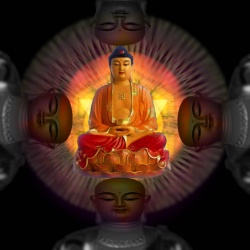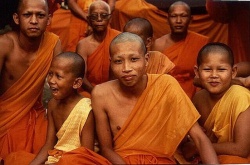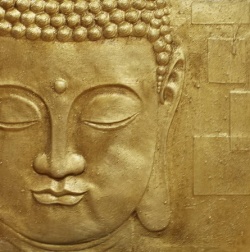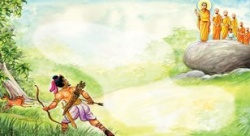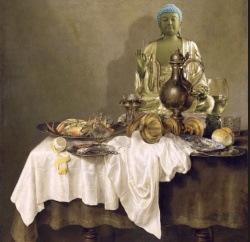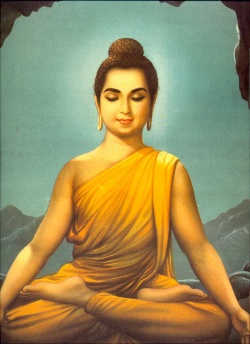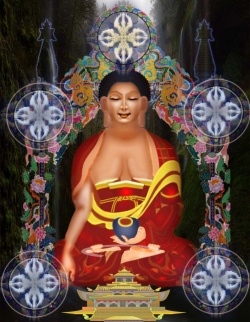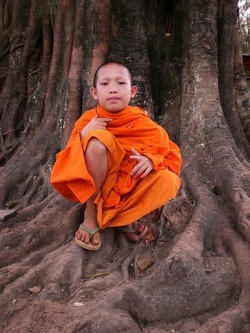Buddhism as a Religion of Universal Appeal and Communal Harmony: Exploring the Impact on Socio-Cultural Fabric of Punjab by Dr. Mohammad Idris Lourey
Buddhism as a Religion of Universal Appeal and Communal Harmony:
Exploring the Impact on Socio-Cultural Fabric of Punjab
By
Dr. Mohammad Idris Lourey
Department of History, Punjabi University
Introduction
Punjab is the land where two religions, Hinduism and Sikhism, took its birth and spread out in various parts of the world. Punjab has been the land of experimenting ground for religious fermentation. Islam is the foremost example in this context. The followers of Islam got a new experience in Punjab, and that was communal harmony and universal appeal. Such significant aspects of social life of Punjab remained even after facing the invaders, intermingling with the foreign travelers and contesting the natural calamities for long duration in the history of this region. Emergence and expansion of Sikhism and continuation of Sufi traditions carried forward these two set of ideas deep into their doctrine and practices. The form of Islam had never been that much conservative in the land of Punjab as it had been in various parts of the world. Such observation can easily be made in the contemporary East and West Punjab by interacting various Islamic societies. Communal harmony and universal appeal has been so much vibrant, that the people of Punjab had “always lived together-together” and not “together-separately”. This site of communal harmony and universal appeal needs to be explored in the light of historical understanding of the region.
Against this backdrop paper argues that the journey of ideas of universal appeal and communal harmony is the core of all major religions in this region since ages. However, the present paper tries to explore the journey of the ideas of communal harmony and universal appeal since the times of Buddhism in the region to the present times. In this light, the first section of the paper presents a over-view of the geographical understanding of the land of Punjab along with elaborating the religion and cultural significance of the word Punjab. In the subsequent sections of the paper elaborates on the Buddhist sites apart from exploring the conceptual collaborations of the ideas of communal harmony and universal appeal. The empathesis is primarily upon the question, as to what role Buddhism had played to deepen the core of the social and cultural life of region.
I
The word Punjab derives its roots from a Persian compound comprising the words of Panj (five) and ab (water). It means land of five rivers which was watered by the Jhelum, the Chenab, the Ravi, the Beas, and the Sutlej.[1] For the purpose of this paper the geographical horizon of ancient Punjab is considered to be the area of land covered by other three names found in ancient historical literature. These three names are; the Regvadic Saptasindhu, the land watered by seven rivers which are believed to have been; Jhelum (Vitasta), Chenab (Askini), Ravi (Parushni), Beas (Vipash), Sutlej (Sutudri), Indus (Sindhu) and Sarasvati (Sarsuti). The epics, Purans Panchanada, the Uttarapatha of Buddhist and Brahmnical texts denote land of five rivers.[2] The Mahabharata clearly mentions the names of these five rivers together with Sindhu as the sixth. When Greeks conquered and occupied this region they called it Pentapotamia. In Greek language it means ‘country of five rivers.’ The ‘Panchanada’ of the Mahabharata may be taken as the nearest equivalent of ‘the Punjab’ of Persian sources, while the Uttarapatha denotes the great north-western division of Bhartavarsa.[3] In the medieval times, the Punjab was known as Suba-i-Lahore. Abul Fazl was the first to coin in Ain-i-Akbari the term Punjab for above mentioned geographical areas.[4] In 1947, with the Independence of India, Punjab was divided into two parts; East Punjab remained with India and West Punjab went to Pakistan. In 1952 Himachal Pardesh and 1966 Haryana were detached from the Indian Punjab.
Historically, Punjab was bounded towards the North by Himachal ranges, on the West by Suliaman and Kirthar hills, on the East by Yamuna and on the South by Sindh and Rajputana deserts.[5] The length and breadth of the Punjab were then respectively about 800 and 650 miles.[6] Some important cities of Buddhists in this region are Kurukhestra, Rohtak, Sirhind, Sanghol, Jalandhar, Patti, Asrur, Sialkot, Agroha, Taxila, Kangra, Mandi and Kulu.
The historical beginnings of Buddhism took place with the appearance of Goutama Buddha (B.C. 624-544 or B.C.466-486). His family name was Goutama. Buddha means learned, wise or intellectual or one who knows truth. He was born at Lumbini garden as the son of Suddhodhana, the chief of the Sakya clan of Kapilvastu in the Nepal Trai. His mother’s name was Maya, a princess of the neighboring clan of Koliyas and after one week of child birth, she died. Goutama was brought up by his aunt and step mother Parajapati Goutami.[7] There is extensive historical and religious literature both in ancient and modern languages dealing with Goutama’s renunciation of home-life and austerities (for six years), his enlightenment at Bodhagaya, his first sermon at Sarmnatha (near Varanasi), his foundation of the Samagha and missionary activities (of forty-five years) and his passing away (at the age of eight years) at Kusinagara. These are the historical and legendry details concerning the life and works of Goutama which need not be reproduced here.
In sixth century B.C., North India was politically divided into monarchial and non-monarchial states. The names of the monarchial states were Angra, Magahda, Kasi, Kosala, Vatsa, Kuru, Panchala, Gandhara and Kamboja. The non-monarchial states were of those of the Sakyas of Kapilvastu, the Kalingas of the Resaputta, the Mauryas of Pippharvana etc.[8]
II
Goutama Buddha visited some places in Punjab. During his visits to the Kuru generally he stayed at Kammasadhamma a market town of the Kuru people. Kuru or Kurukhestra occupied an important place in the religious and geographical history of ancient Punjab and north-west India because it was the boundary line between Uttarapatha and Madhyadesa divisions.[9] Various inscriptions written in Brahmi, Kharosthi, Armaic and Greek, discovered from the region, bear testimony to the existence of Buddhism up to the borders of Persia and South Russia including Afghanistan.
According to the Buddhist traditions, Goutama Buddha visited Kurukshetra in course of his missionary tours and possibly Bhaddiyanagara i.e. Sialkot and Anguttarapa i.e. Agroha in Hissar district.[10] The names of the Suttas delivered by Buddha at Kammasadhamma in Kurukshetra are;
- (a) Majjhima Nikayala (middle Discourse no-10) on the foundations of mindfulness of the body, feelings, consciousness, and mental objects.
- (b) Digha Nikaya (long Discourses no-15) on the law of Paticceasamuppada, the doctrine of Dependent organization.
- (c) Samyutta Nikaya (kindred sayings).
- (d) Angutta Nikaya (general sayings); a discourse on ten noble states (ariyavasa). [11]
According to Mahavastu, Goutama Buddha had converted the people of Kurukhestra Janapada, the country around Delhi-Kurukeshetra-Thaneswar (modern Ambala division).[12] The Pali texts also mention a town called Kammasadhamma in Kuru country which was frequently visited by the Buddha, where he gave one of the most profound discourses. [13] Pali literature also contains many details concerning Kuru country and its people who were of good conduct and endowed with wisdom. The Kurudharama-Jataka assumes that Kuru country was a Buddhist country.[14] Kurudhamma is understood to mean Buddhist teachings of five moral percepts (Panca-sila). The capital of the Kuru was Indapatta (Indaprastha) in the outskirts of modern Delhi.[15]
In Kuru country Thullakotthika, where Buddha once stayed and delivered the Ratthapalasutta and ordained a noble called Ratthapala, as a bhikshu and had him included in the Buddhist Sangha.[16] It was another important town of Buddhism in Kuru country and received its name because of its granaries.[17] Buddha also stayed at a small village Srughana, now called Sugh about 5 kilometers to the East of Jaghadhari in Haryana state. The earliest reference to Srughna occurs in Tatittriya Aranyaka, where it has been apparently misspelled as Turghna. From Buddha’s times, it always remained in the limelight. One reason probably was its location on an important East to West trade route. It is also mentioned in the Buddhist works like Mahamayuri [18] and Divyaava dana. [19] Srughuna is also described in some detail by Hieun Tsang who visited it in seventh century A.D. He mentions an Asokan stupa and monastery to south-west of the city apart from many other stupas.[20]
Sakala (in Pali ‘Sagala’) has been identified with modern Sialkot. Bhadramkara is another name of Sakala. According to Mulasarvastivaa-Vinayas reports that Bhuddha had visited the town called Bhadramkara accompanied by many monks. Vinaya reports also narrate the story of a virtuous house holder of Bhadramakara named Mendhaka and his conversion to Buddhism. [21] This story means that Buddha had visited modern Sialkot in the Western Punjab and the people of Punjab embraced Buddhism in early sixth century B.C. [22] In his treatise ‘Ancient People of the Punjab’ Przyluski has identified Bhadramakara with Sakala (Sialkot) and Anguttarapa with Agroha, an ancient city 13 miles North-West of Hissar.[23] In ancient times, there was a great trade route which passed through Sialkot, Agroha and Rohitaka connecting Taxila with Gangetic valley. According to Buddhist traditions Buddha travelled by this route. [24]
Taksasila or Taxila (near modern Rawalpindi district of Western Punjab in Pakistan) was a famous centre of learning in and around the age of Buddha. It is mentioned in Buddhist texts that the Goutama Buddha may have visited Taxila.[25] Taxila was a city of par excellence immediately before the invasion of Alexander. It was not only a metropolitan city but also a great centre of education. The name and fame of the University of Taxila had spread far and wide due to which the princes of various kingdoms flocked around to get education in different fields of learning including polity, warfare, and medicine.[26]
When Buddhism attained predominance here, Taxila University developed into an important centre of Buddhist studies. An outstanding personality of Taxila University was Kumaralata (Tung-Shou in Chinese), who was well versed in the sacred literature of Buddhism and Buddhist philosophy. He was the founder of Sautrantika School of Buddhism and has to his credit a number of works. Jivaka Kumarabhrtya of Avanti was the most famous physician and surgeon of North India in the age of Buddha. The Mulasarvastuada- Vinaya relates a legend of Jivaka’s visit to the Punjab i.e. King Bimbisara of Maghda had given a letter to Jivaka to be delivered to King Pushkarasarin of Gandhara. On his journey he passed through Udumbara, Rohitaka, Mathura and Vaisali.[27] This account shows that traders, religious preachers and students from Gangetic valley and eastern part of India often visited Punjab and other north-western regions of India in 600-500 B.C.[28] In the north-west India Udyana (Swat valley) was another flourishing centre of Buddhism. Here Vimoksasena, an outstanding scholar in the Abhidharma or the metaphysical literature of Buddhism translated a number of Buddhist works into Chinese in the second half of the Sixth Century, when Hieun Tsang visited Udyana (Swat) there were 1400 monasteries with about 1800 priests belonging to five Buddhist schools viz., the Dharmaguptas, the Mahisakas, the Kasyapiyas, the Sarvastivadins, and the Mahasamghikas. [29] Hieun Tsang also records that he saw the cave inhabited by the King Gopala (Gopala-nagaraja), in this cave Buddha had left his shadow or rather a luminous image of Himself in the rock. The conversion of another Naga King Appala, near the source of Swat River west of the Indus by Buddha is related by the Hieun Tsang in his description of Udyana.[30]
Sindh is also well known to the ancient Buddhist texts. It was an important centre of Sammatiya School of Buddhism which had about 10,000 monks residing in several hundreds of monasteries. According to Hieun Tsang they were thorough believers of Buddhism, who lead lives of the lonely seclusion. Goutama Buddha had also visited Mandivardhana, which lay between Jalalabad and Peshawar and converted its king along with his family into Buddhism. The name of the king is given as Bhavadeva or Bhutideva. [31]
Jalandhara became a prominent centre of Buddhist studies probably during the period of the Khusanas, where according to Buddhist traditions, fourth Council was said to have taken place. Jalandhara continued to remain a flourishing centre. Hieun Tsang also sojourned here for four months studying the Prakarapada-Vibhara-sastra from eminent scholar Chandravarma, well-versed in the Tripitakas. [32]
Sanghol is the name of a village in Samarala tehsil in the Ludhiana district of the Punjab. It is situated 60 kilometers from Ludhiana and 40 kilometers from Chandigarh on the Ludhiana-Chandigarh road. The name Sanghol might have been derived from Samghalaya, a ‘Home of Samgha or Samghapura’ meaning a town of Samgha for the reason that there were located some Buddhist monasteries. It was one of the largest Buddhist monastic establishments in the ancient Punjab. Hiuen Tsang here saw as many as ten monasteries in the Seventh Century. At that time it was the capital of the Satadru kingdom. The other cities sanctified by Buddha in Punjab are Gurgaon, Karnal, Kangra, Kulu, Mandi, Patti and Sihind etc.[33]
III
Since all the informations reproduced above are from Sanskrit and Chinese translated Buddhist sources which may not be historically true, nevertheless, one would not be justified in dismissing these informations or legends as entirely valueless for reconstructing a history of Buddhism for its contribution towards Communal Harmony in these Buddhist centres and for exploring the socio-cultural and architectural history of the Punjab. At least these details and legends seem to convince us about sociological, cultural and archeological impacts of Buddhism on the minds of people of the Punjab during the life time of the Buddha and also during the medieval and modern Punjab.[34]
Buddhism as a humanist force, acted as a powerful factor in transforming existing social conditions of this region. It is a religion of kindness, humanity and equality. Buddhism denounced all claims to superiority on the ground of birth as the brahamans claimed. It denounced all social distinctions between men and declared that it was the Karma, the actions of man, that determined the eminence or lowness of an individual.[35] The position of Buddhists in this respect is appreciated and accepted in Mahabharta.[36] Equality of social status based on one’s actions and not on race is an integral part of the literature of medieval saints like Ramananda, Chaitnaya, Kabir, Eknath, and others during Fourteenth to Seventeenth Century. Another feature of great sociological significance in Buddhism is the fact that it opened the doors of organized religious life to men and women alike. In Buddha’s days, this was a great forward step and in religious life, women enjoyed the same rights of access to the highest positions. Buddhism recognized that women could also be as learned and wise as counterpart men.[37] Nevertheless, it must be remembered that this should not be judged by the standards of the Twentieth Century world.
During His lifetime, the Buddha allowed things to be decided democratically by the Sangha; and after His death too, He did not want to restrict the freedom of the Sangha by appointing His own successor. He wanted the Dhamma and Vinaya to be its guides after His death and anything which was not authorized by the Dhamma and Vinaya was to be rejected by the Sangha.[38] The great popularity of Buddhist ideas and practices compelled the Brahmana thinkers and writers of Dharmashastras of Smritis to make compromise with orthodox views. They also accepted several non-Vedic ideas and practices of Buddhist origin. Thus the introduction of Samnyasasasharma took place. In contrast to Vedic Brahmanical theory, the Buddhist teachers disregarded rules of caste and creed. The Buddhist teachers also disregarded distinctions and differences based on sex, colour and status. During the different periods of religious history of Punjab, people of all classes were attracted by Buddhism. With the influence of the teachings of Buddha and latter on His preachers the rigidity of caste system was considerably modified.
Religious and social freedom is also imprinted in the Buddhist sites in Punjab and during Buddha’s age, it witnessed important changes particularly in the socio-cultural fabric. Buddha was a great traveler. He has left His footprints on the soil of India and his mark on soul of mankind. He played significant part in shaping the social, cultural, and religious outlook of Punjab. With his visits, urbanizations of the cities like Kashyapapura (Multan), Takshasila (Taxila), Mathura, Shravasti, Vaishali, Kashi, Kurukshetra etc. progressed. These cities became the centers of Buddhist cultural life. The Vedic and rigid religious institutions had also declined in the Buddhist cities of Punjab due to the influence of Buddhism.[39]
In the economic field, during the Sixth century B.C. Taxila city was a great centre of trade and commerce, where merchants came from different parts of India and from central Asian countries.[40] It was the capital of King Puskarasarin of Gandhara and as already mentioned a prime seat of learning and education in the age of Buddha, kept up its own monastic character. [41] In the Chinese travelers and pilgrims accounts, it clearly appears that admission to the Taxila University was not restricted to monks of different Buddhist schools, but also to untrained seekers of Buddhist learning, even presumably to non-Buddhists. [42] In the history, the Indian logic Medieval School is almost entirely represented by Buddhism.[43]
In the field of cultural development of Punjab, one of the far-reaching consequences was in the process of growth of monasteries into seats of learning and the dissolution of the inbred character of their old monastic teachings. The monks were trained in more varied cultural subjects-the tenets of other faiths, in systems of philosophy, Buddhist thought, and subjects of pragmatic importance like agriculture, architecture, etc. [44] The educational activity in monasteries which was originally restricted to Buddhist studies, extended in due course to cover all subjects of knowledge. The Buddhists were the first to recognize the importance of literacy.[45] The way in which Buddha and His disciples taught over the centuries is more important in the context of today’s education system.
The growth of Buddhist art in all fields-architecture, sculpture, painting, and handicraft should be viewed both as a contributory cause as well as a consequence of the progress and popularity of Buddhism. In this context, architectural and archaeological fabric of Punjab is very important. Building and maintenance of schools and colleges for the study of Dharma was a sacred deed. In other words, Buddhist art is largely religious in content. In Buddhist architecture, we find three technical terms; Stupa, Caitya and Vihara.[46] All these indicate different forms of Buddhist religious architecture. It is said that Emperor Asoka had built 84000 stupas all over his vast empire. Stupa means a kind of closed shrine. The word Caitya means a sacred symbol; it may be a stupa, shrine, tree or pillar. The word Vihara means a monastery. From the available sources, we infer that there are nearly 1000 rock-cut Buddhist monumental monasteries in India.[47] Marvelous achievements were recorded by Buddhist sculpture both in quality and quantity. The earliest examples of Buddhist sculpture are those of the capitals of Asokan stone pillars. The Sarnath Lion Capital of Asokan pillar, now adopted as the National Emblem of India, is one of the masterpieces of classical Buddhist sculpture.[48]
Buddhism also manifested its cultural creativity in Punjab through the sculpture, architecture and painting in a grand manner. Apart from its aesthetic value, Buddhist art has been an important means of education and cultural progress not only in Punjab, North-West India but also among other nations of Asia. In several cases, artistic monuments have supplied valuable historical data for the history and interpretations of Buddhist systems of thought and its universal appeal for communal harmony and liberal religious ways.
In many countries, Six Century B.C was remarkable for the spiritual unrest and intellectual fermentation. We had in Greece Parmenides and Empedocles, in Iran Zarathustra, in China Lao Tzu Confucius and in India Mahavira and Goutama Buddha. In that period many other remarkable teachers worked upon their inheritance and developed new ideas. In the life of Buddha there are two sides, individual and social. Buddhism is a religion of kindness, humanity and equality. In the world Buddhism has been a great force of universal peace. It is a missionary religion with universal appeal. The Buddha taught His doctrines by traveling to far flung places.
From ancient times, India has a long tradition of peaceful co-operation among the different cultures and religions. India has no sense of cultural and religious isolation. Indian secularism is a positive concept in the world. It implies positive goodwill and respect for all religions and India has also maintained peaceful international relations. So in shaping the idea of what it is today, Buddhist teachings, literature and heritage have had a profound impact on the socio-cultural life of the people, particularly the people of North-West India-the Punjab. The Buddhist saints, scholars, poets and philosophers enriched the cultural and religious history of the region. The Buddhist monuments and sites are a testimony to the fact that the life of the people was so deeply influenced by the basic tenets of universal appeal and communal harmony that in spite of existence of major religions, the people of this region don't live together-separately but together-together. There are no distinctions and differences based on sex, caste and creed. The rigidity of caste system in Punjab stand considerably modified and so does other cultural aspects, tenets and customs. To a large extent, it can be attributed to the fact that Punjab is a land of peaceful coexistence. The Twenty-five centuries history of Buddhism in Punjab has been able to bring significant transformations in culture, architecture, archeological and overall socio-economic life of the people of this region, thus, timely making it a place of universal peace, harmony and religious tolerance.
Footnotes
- ↑ D. C. Sircar, 'Ancient Geography of the Punjab', L. M. Joshi, and Fauja Singh (eds.), History of the Punjab (From Pre Historic Times to the Age of Asoka), Publication Bureau, Punjabi University, Patiala, 1989, p. 25
- ↑ G. P. Malalasekera, Dictionary of Pali Proper Names, London, 1960, reprinted, vol. I, p. 363.
- ↑ Mahabharata, P. C. Roy, English Translation, reprinted, New Delhi, 1970, Adiparvan, 3. 172.
- ↑ Abul Fazl, Ain-i-Akbari, English Translation Blochmann, Calcutta, 1927, pp. 14-15.
- ↑ D. C. Sircar, Ancient Geography of the Punjab, L. M. Joshi, and Fauja Singh (eds.), History of the Punjab (From Pre Historic Times to the Age of Asoka), p. 26.
- ↑ Steinbach, The Punjab, Language Department, Punjab, Patiala, reprint, 1970, pp. 1-2.
- ↑ Vishwanath Prasad Verma, Early Buddhism and Its Origin, Munshiram Manoharlal Publishers, New Delhi, 1973, p. 5.
- ↑ G. C. Pandey, Studies in the Origins of Buddhism, Allahabad, p. 256.
- ↑ Kashyap, J (ed.), Mahavagga, Nalanda, 1956, p. 23
- ↑ Sircar, D. C, Select Inscriptions Bearing on Indian History and Culture, Civilization, Calcutta, 1965, second edition, vol. I, p. 103.
- ↑ Basak, Radhagovinda, (ed.) Mahavastu, Calcutta, vol. II, 1964, p. 564, Anga-Magahda-Vajji-Malla-Kasi -Kosala-Kuru-Pancala-Ceti- Vatsa-Matsya-Surasena etc.
- ↑ Basak, Radhagopala, (ed.), Mahavastu,, p. 564, Asvaka-Avanti-Dasadism
- ↑ J. Kashyap, (ed.), Kurudhamma-Jataka, Nalanda, 1959, p. 58.
- ↑ Ibid., p. 220.
- ↑ L.M. Joshi, Buddhism in the Punjab, L. M. Joshi, and Fauja Singh, (eds.), History of the Punjab (From Pre Historic Times to the Age of Asoka), p. 194.
- ↑ J. Kashyap, (ed.), Majjhimanikaya, Nalanda, 1959, vol. I, p. 76.
- ↑ J. Kashyap, (ed.), Kurudhamma-Jataka, p. 59.
- ↑ Ahir D. C, Buddhism in the Punjab, Haryana and Himachal, Sri Satguru Publication, New Delhi, 1966, p.13
- ↑ Vaidya, P. L, (ed.), Divyavadana, Dharbhanga, 1959, p. 77.
- ↑ G. P. Malalasekera, Dictionary of Pali Proper Names, London, 1960, reprinted, vol. I, p. 529.
- ↑ S. Bagchi, (ed.), Mulasarvastivada-Vinaya, Darbhanga, 1967, pp. 184.
- ↑ G. P. Malalasekera, Dictionary of Pali Proper Names, p.530.
- ↑ J. Przyluski, 'Ancient People of the Punjab: The Udumbaras', reprinted in Indian Studies; Past and Present, vol. I, no. 4, 1960, p. 9.
- ↑ S. Bagchi, (ed.), Mulasarvastivada-Vinaya, p. 189.
- ↑ Radhakumud Mookerjee, Ancient Indian Education, Delhi, 1960, second edition, p. 478.
- ↑ Thomas Watters, On Yuan Chwang's Travels in India, Delhi, 1961, reprinted, vol. pp. 183-184.
- ↑ S. Bagchi, (ed.), Mulasarvastivada-Vinaya, p. 190.
- ↑ L.M. Joshi, Buddhism in the Punjab, L. M. Joshi, and Fauja Singh, (eds.), History of the Punjab (From Pre Historic Times to the Age of Asoka), p. 195.
- ↑ S. Bagchi, (ed.), Mulasarvastivada-Vinaya, p. 188.
- ↑ D. C. Sicar, Select Inscriptions Bearing on Indian History and Culture, Civilization, p. 96.
- ↑ Hseun Tsang,
- ↑ Ibid.
- ↑ D. C. Ahir, Buddhism in the Punjab, Haryana and Himachal, p. 16.
- ↑ P. V. Bapat (ed.), 2500 Years of Buddhism, Publication Division, Ministry of Information and Broadcasting, Government of India, New Delhi, 1959, pp. 1-2.
- ↑ Ibid., p. 5.
- ↑ Mahamayuri, II, 23, 60.
- ↑ P. L, Vaidya, (ed.), Divyavadana, Dharbhanga, 1959, p. 47.
- ↑ Thomas Watters, On Yuan Chwang's Travels in India, p.185.
- ↑ G. P. Malalasekera, Dictionary of Pali Proper Names, pp. 982-983.
- ↑ P. V. Bapat (ed.), 2500 Years of Buddhism, p. 161.
- ↑ Ibid.,
- ↑ S. C. Vidyabhusana, A History of Indian Logic; Medieval School, Calcutta, 1921, pp. 225-227.
- ↑ Ibid., p. 228.
- ↑ Ananda W. P. Guruge, Contribution of Buddhism to Education, P. N. Chopra, (ed.) Contribution of Buddhism to the World Civilization and Culture, p. 101.
- ↑ Ibid., p. 125.
- ↑ Ibid.,
- ↑ L. M. Joshi, Buddhist Contribution to Art and Architecture, P. N. Chopra, (ed.) Contribution of Buddhism to the World Civilization and Culture, p. 163.
- ↑ Ibid., p. 165.
Source
Buddhism And Australia Conference 2015 http://buddhismandaustralia.com/
